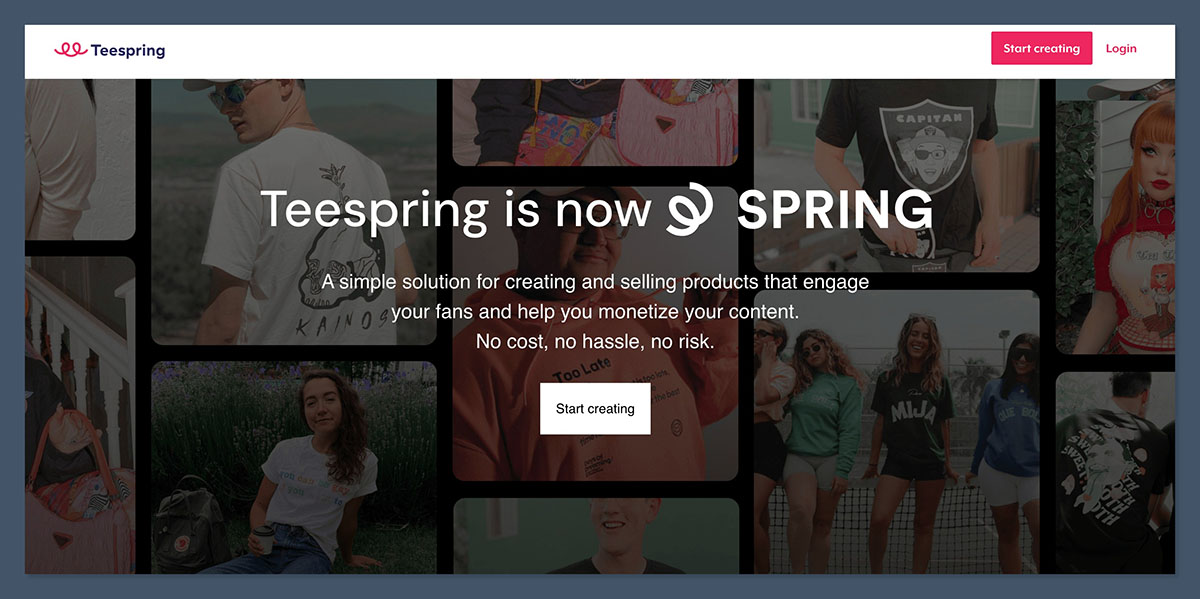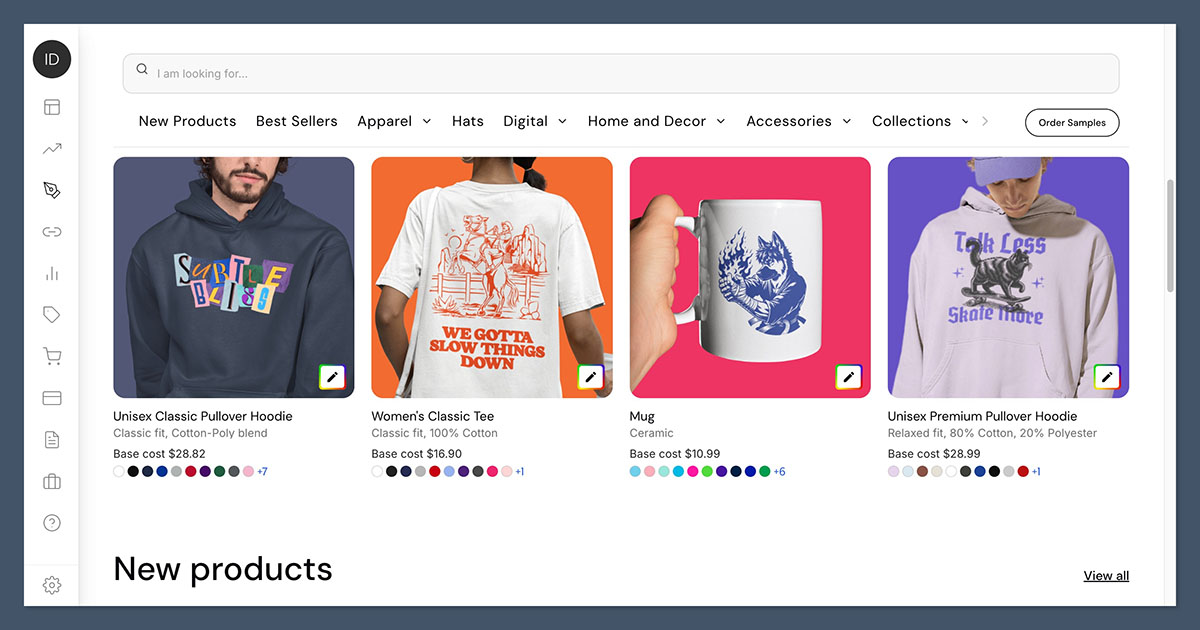Quick answer: Teespring (now branded as Spring) is a solid option if you’re just testing the waters of print on demand and want zero upfront costs.
But if you’re serious about building a brand or controlling your customer experience, it won’t get you far. It’s convenient — but convenience comes at the cost of control, profit margins, and scalability.
Teespring is a no-cost print on demand platform that lets you sell custom products without handling inventory, shipping, or support. It’s built for creators, not ecommerce pros — but that doesn’t mean it’s the right choice for everyone.
I’ve been in the POD space for over 10 years, testing platforms like Printify, Printful, Gelato, Redbubble, Etsy, and yes — Teespring. After running multiple stores and campaigns, I’ve seen exactly where Teespring delivers… and where it cuts corners.
In this review, I’ll break down Teespring’s pros, cons, real-world margins, who it’s best for, and where it falls short — all based on personal results, not theory.
Let me break it down for you.
What Is Teespring and How Does It Work?

I’ve used Teespring since back when they were just pushing viral meme tees through Facebook ads. It’s come a long way since then — now rebranded as Spring, the platform is more polished, better integrated, and still completely beginner-friendly.
At its core, Spring is a fully hosted print on demand (POD) service. You don’t need to buy a domain, build a store, or touch any code.
There’s no Shopify subscription, no Zapier automations, no fulfilment headaches. It’s as plug-and-play as it gets.
You sign up, pick a product from their catalog — t-shirts, mugs, hoodies, stickers, posters, phone cases — upload your design, set your pricing, and you’re live. Spring automatically generates a product page that they host for you.
There’s no upfront cost at all. You only make money when someone buys. That order triggers everything automatically: the item gets printed, packed, and shipped — and you get your cut.
Here’s the typical process:
- Design a product using their online builder
- Set your pricing and publish it
- Spring creates and hosts a product page
- Share your link or connect your social accounts
- Sales come in, Spring handles printing and shipping
- You receive profit via PayPal or Payoneer
They’ve also integrated directly with major platforms like YouTube Merch Shelf, Instagram Shopping, and Linktree, so if you’ve already built an audience, it’s easy to plug in and start selling immediately.
But here’s the trade-off — you don’t really own anything.
You’re not building a store. You’re not building a brand. You don’t collect email addresses. You can’t run proper retargeting ads. Everything lives on their platform. And if they shut down your account, that’s it — you’re out.
Also worth noting — while setup is quick, customisation is minimal. You can’t fully change product page layouts, and your storefront options are limited to basic themes and colour tweaks.
This is fine for creators selling merch, but frustrating if you’re used to Shopify-level flexibility.
Verdict:
It’s easy. It’s fast. You won’t spend a dime to get started. But you give up ownership, data, and control in exchange.
Is Teespring Worth It in 2025?
Honestly? Depends on what you’re really trying to do.
If you’re just testing ideas, riding a trend, or using your existing social following to throw up some merch — Teespring works. It’s built for simplicity. You don’t need to worry about inventory, warehousing, or customer service.
For low-effort monetisation, it’s one of the easiest ways to start selling physical products.
But if your plan is to build a real business — one with loyal customers, email marketing, custom packaging, consistent branding, upsells, and customer retention — Teespring falls flat. You’ll hit a ceiling fast.
There’s no abandoned cart recovery. No custom domain. No ownership of customer data. You can’t tweak the checkout experience, run post-purchase upsells, or build out a proper sales funnel.
That might not sound like a big deal early on, but trust me — it is.
So here’s how I’d break it down:
Teespring is a good fit if you:
- Want to test POD designs without spending money
- Already have traffic from YouTube, TikTok, Instagram or Twitter
- Just need a basic merch store for your followers
- Don’t want to touch logistics, customer service or fulfilment
Teespring is not a good fit if you:
- Want to build a long-term ecommerce brand
- Need full control over pricing, branding, and product quality
- Care about owning your customer data and running ads
- Rely on profit margins to reinvest in growth
My own experience:
I listed 12 products over the last 18 months to test how passive the income really was. Most of my sales came from linking in YouTube descriptions and Twitter threads. The orders came through automatically, support was handled by Spring, and I got paid without any effort.
That sounds ideal — but I had no idea who bought from me. No emails. No remarketing. No control over the experience. There was no way to nurture those buyers or turn them into long-term customers.
It made money, yes — but it didn’t build anything I could grow.
Verdict:
It’s fine if you’re casual or just selling for fun. But if you want to scale, grow, or build a business you actually own — Teespring won’t get you there.
Teespring Pros and Cons
After more than a decade working with different POD platforms, I can tell you: every tool has trade-offs. Teespring is no different. It does a few things well, and a few things painfully average. Let’s break it down.
The Upside
The biggest win with Teespring is zero risk. You can launch a product line without spending a single dollar. That’s powerful — especially if you’re just testing ideas or have a decent following already.
It’s also built for ease of use. No need to set up a Shopify store, configure apps, or manage plugins. Everything from design to fulfilment is baked into the platform.
If you’ve got an audience, you can start selling in a day.
Some of the key benefits:
- No upfront costs — you only pay when a product is sold
- Built-in integrations with platforms like YouTube, Twitch, Linktree
- Decent print quality for basic apparel and accessories like mugs, stickers, and tees
- No fulfilment or customer support to handle — Spring takes care of it all
- Quick to launch — no need to buy a domain, set up checkout flows, or hire designers
This kind of convenience is why I still use it for certain one-off merch drops. It just works — no friction.
The Downsides
Now for the flip side.
Let’s talk margins first. If you’re selling a t-shirt for $24.99, your profit might only be around $8–$10. That’s not horrible if you’re bringing in volume, but it’s tight if you plan to run ads or scale.
And if your designs need higher-end products, like embroidered hoodies or cut-and-sew blanks — forget it. The range just isn’t there.
Then there’s the lack of ownership. You can’t build a customer email list. You can’t install tracking pixels. You can’t A/B test checkout flows.
Everything lives on Spring’s platform, which means you’re renting space, not building your own business.
Downsides worth knowing:
- Low profit margins — hard to scale without volume
- You don’t own your customer data — no retargeting or email marketing
- Limited product variety — less selection than Printful, Gelato, or even Printify
- Slower shipping for customers outside the US or EU
- Basic storefront customisation — not ideal for branding or unique design
It’s also worth mentioning that support isn’t instant. If a customer has an issue, you’re not directly handling it — which can be a blessing or a curse depending on the situation.
Verdict:
Teespring is low-risk and easy, but you give up profit, flexibility, and ownership. Great for merch. Not built for brand builders.
What About Profit Margins?
This is where Teespring starts to feel a bit tight.
Sure, you can set your own prices — but there’s a ceiling on what people are willing to pay, especially if you’re not a recognised brand.
You can’t just slap a logo on a blank hoodie and expect $60 sales. You’ll get undercut by bigger names or ignored altogether.
Here’s what margins typically look like in 2025:
| Product | Base Cost | Selling Price | Your Profit |
|---|---|---|---|
| T-shirt | $10.22 | $24.99 | $9.77 |
| Hoodie | $21.64 | $44.99 | $13.35 |
| Mug | $7.31 | $19.99 | $12.68 |
Not awful. But not exciting either — especially if you’re hoping to run paid ads, offer discounts, or absorb returns.
Most of the creators I know use Teespring to make some light passive income off an existing audience. If you’re relying on it as your main ecommerce engine, you’re going to feel the margin squeeze fast.
Also keep in mind:
- Shipping isn’t included in your margin — the customer pays it, but it still affects perceived value
- Teespring occasionally tweaks base pricing, and they don’t always announce it clearly
- You can’t easily bundle products or upsell without 3rd-party hacks
So while it’s nice to pocket $10 per sale, that figure rarely scales — and definitely doesn’t compare to platforms where you can control the full experience, upsell flow, and brand loyalty.
Verdict:
It’s fast cash if you’ve got traffic. But if you want long-term revenue, the margins just don’t cut it.
Teespring vs Redbubble vs Etsy vs Shopify POD
I’ve run stores on Teespring, Redbubble, Etsy, and Shopify + Printify — and they all serve different purposes.
If you’re serious about print on demand, knowing how they stack up is key. Here’s the honest breakdown from someone who’s lived through each one.
Teespring vs Redbubble
- Teespring: You’re responsible for traffic. No marketplace. It’s more of a fulfilment tool than a discovery platform. You sell through your own links — from YouTube, TikTok, Linktree, etc.
- Redbubble: Built-in marketplace traffic. People already shop there for quirky designs. You can actually get sales without having a social following or ad budget.
With Redbubble, your listing can be found through search, tags, or their homepage feeds. Teespring doesn’t offer that — it’s 100% dependent on your own audience or marketing.
Redbubble’s downside? You have almost no control over your storefront or pricing strategy, and their royalty payouts are even tighter.
Verdict:
Redbubble wins for artists or designers without an audience. Teespring requires marketing chops.
Teespring vs Etsy
- Teespring: You don’t get access to customer emails. You don’t control branding. It’s built for simplicity, not flexibility.
- Etsy: You can build a real store page, get reviews, create email sequences, and tap into organic traffic. It also feels more personal — customers trust Etsy more than a Teespring store page.
That said, Etsy’s fees can stack up fast. You’ve got listing fees, transaction fees, payment processing, and optional ads. And you’re still subject to their rules and algorithm.
But in terms of customer trust and long-term brand equity? Etsy gives you tools that Teespring just doesn’t.
Verdict:
Etsy is better for building credibility, a following, and a customer list — if you’re willing to put in the extra effort.
Teespring vs Shopify + Printify
- Teespring: You can go live in under an hour with no costs. It’s good for testing or short-term selling.
- Shopify + Printify: You’ll need to pay monthly fees and do more setup — but the payoff is control. You own everything. From checkout to email list to upsells.
With Shopify + Printify, you can:
- Install apps for bundling, subscriptions, loyalty programs
- Set up retargeting and cart recovery
- Customise every inch of your store
- Run proper ad campaigns with pixel tracking
It’s more work — and more upfront investment — but it’s a foundation you can build on.
Verdict:
Shopify + Printify wins for serious brand builders. Teespring is great if you’re testing, but doesn’t scale well.
Overall Verdict:
Teespring is the fastest to launch, and great for creators with an audience — but long-term, it loses out to platforms that offer more control, data, and flexibility.
Real Results: My Sales on Teespring

Let’s talk actual numbers — no fluff.
I launched a 12-product niche collection on Teespring in Q1 2024. This wasn’t a major campaign or ad-driven push — just a small merch drop tied to some niche content I was publishing on Twitter and YouTube.
Here’s what I pulled in:
- Total revenue: $2,372
- Total profit: $688
- Return rate: 3%
- Top sellers: Mugs and black hoodies (by a long shot)
I priced everything fairly middle of the road — not bargain basement, but nothing premium either.
I leaned on mugs and hoodies since those have historically given me better profit per unit and sell well across casual and gift-buying audiences.
A few things stood out.
What I Learned:
- Mobile matters most
Over 80% of traffic came from mobile. Product images needed to pop on small screens, and anything with too much text flopped. Clean, bold visuals worked best. - Spring’s backend has limits
I couldn’t track abandoned carts. I couldn’t split test. I had zero insight into why certain products were converting better than others. It was a blindfolded run. - Organic traffic was the only driver
Almost every sale came from social links — mostly Twitter threads, YouTube descriptions, and my Linktree bio. No one just “found” my Teespring store. Without existing content, I wouldn’t have made anything. - No repeat customer strategy
Even though I had repeat buyers (confirmed via product reports), I couldn’t retarget them, email them, or learn anything useful. That stung the most — the money was there, but I had no way to turn it into something bigger.
For context, I’ve run similar drops on Shopify using Printify and made nearly double the profit from the same traffic — just by controlling the funnel, using upsells, and offering bundles.
Verdict:
It works. You can make sales. But the growth potential is tiny unless you already have a steady audience — and even then, it leaves money on the table.
Is Teespring Good for Beginners?
Yes and no — depends on what kind of beginner you are.
If you’ve never sold anything online, Teespring is one of the easiest places to start.
The platform does a lot of the heavy lifting: hosting, fulfilment, payments, and even basic product setup. You don’t need to worry about inventory, shipping costs, or customer service. That simplicity makes it very appealing.
You could realistically go from zero to selling within an hour — no website, no budget, no setup stress. For that reason alone, I often recommend Teespring to complete beginners who want to get their feet wet.
But — and this is where it falls short — it won’t teach you real ecommerce. It won’t push you to understand the things that actually matter if you’re building a brand or trying to scale up.
Here’s what it doesn’t give you:
- No email list building tools or customer retention strategies
- No product bundles, quantity discounts, or advanced pricing logic
- No real analytics — just a basic sales report
- No cross-sells, upsells, or abandoned cart recovery features
You’re not learning how to run a store. You’re learning how to upload a design and share a link.
And if you’re serious about POD, there are things you need to understand over time:
- Margins — how much you actually keep per sale
- Customer lifetime value — not just one-off sales
- Funnels — how to move people from interest to purchase to repeat buyer
- Branding — creating something memorable that stands out
Teespring skips all of that. It gives you a shortcut to launch, but no tools to grow.
If you’re curious, it’s a fine starting point. But it won’t take you very far once you’ve got a few sales under your belt.
Verdict:
Beginner-friendly, no doubt. But if you want to level up — you’ll outgrow it fast.
Tips to Make Teespring Work in 2025
Teespring isn’t a full ecommerce solution — but if you play to its strengths, you can still make it work. After running multiple campaigns, I’ve found a few strategies that consistently deliver results, even with Teespring’s limitations.
The platform’s real power lies in its speed to market. You’re not building a store. You’re launching fast, catching attention, and converting off-platform.
So the entire game becomes traffic-focused — not backend optimisation.
Here’s what actually works:
- Use short-form content to drive attention
Platforms like TikTok, Instagram Reels, and YouTube Shorts are goldmines for Teespring sellers. You don’t need a massive audience — you just need a few high-performing posts with strong CTAs. It’s the cheapest way to build momentum organically. - Stick to niche designs that spark emotion
The bestsellers on Teespring aren’t polished, high-end pieces. They’re usually bold slogans, inside jokes, fan culture references, or meme-inspired graphics. If it makes someone say, “That’s so me,” it’s a win. - Don’t act like a brand
Teespring isn’t built for full-scale branding. Forget about brand kits, polished product pages, or story-driven campaigns. Lean into the platform’s low-commitment energy. Drop designs that follow trends, respond to viral content, or ride pop culture waves. - Use urgency to push action
I’ve seen better conversions when I frame designs as limited-time drops. Phrases like “only available this week” or “closing in 48 hours” help push people off the fence. It’s psychological, but it works. - Leverage Linktree and similar tools
Most Teespring traffic comes from bios and pinned comments. Using Linktree (or Beacons, Gumroad or Stan Store) lets you showcase multiple products without needing a full website. You can segment by niche or audience interest and keep things clean.
And the one move that worked better than anything else?
My top-performing tactic:
Using YouTube end screens to plug my Teespring store.
I added a call-to-action on short videos and long-form content. About 37% of all clicks to my store came from those end screen prompts. Super easy to set up, and it consistently drove qualified traffic.
You can also pin your store link in the comments and mention it verbally in the video — this combo triples your exposure.
Verdict:
It’s traffic or nothing. Teespring can convert, but only if you’re feeding it attention from the outside.
Final Verdict: Is Teespring Legit or a Waste of Time?
Let’s clear this up: Teespring is 100% legit.
I’ve sold through the platform. I’ve been paid — consistently, on time. The fulfilment works. Customers receive their orders. Support handles most issues without needing you to step in.
So if your main concern is whether it’s a scam or unreliable — it’s not. It does what it promises.
But here’s the real question: Is Teespring worth your time if you’re serious about POD?
That’s where the line gets drawn.
If you’re just experimenting — maybe you’ve got a following, or you want to test a few product ideas without spending any money — then yes, it makes sense. You can throw up designs, share your link, and start collecting a few passive sales without any upfront cost or technical headaches.
It’s ideal for:
- Content creators who want quick merch drops
- First-timers looking to validate a concept
- Side hustlers trying to monetise niche audiences
- Projects that aren’t meant to scale long-term
But if you’re in this to build something sustainable — a brand, a store, a system that grows over time — Teespring won’t take you there.
It’s not built for:
- Running high-ROI ad campaigns
- Collecting emails or building customer loyalty
- Controlling the customer journey
- Testing conversions or optimising your funnel
- Building a unique visual brand experience
It’s the fast food of POD. It’s quick. Convenient. Gets the job done in a pinch.
But you’re not building a business — you’re making sales on someone else’s land. You don’t own the data. You don’t build a real customer base. And that limits everything.
If I were starting from scratch in 2025, I’d still use Teespring — but only as a temporary launchpad. I’d treat it as a proof-of-concept tool, not a long-term strategy.
Verdict:
Teespring is great for launching, terrible for scaling. Use it to test, then graduate to a platform that lets you actually own and grow your business.






